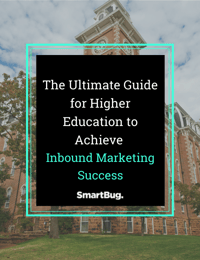
Why You Need Inbound Marketing for Higher Ed
March 7, 2019
With the rise of stealth applicants and digitally savvy prospective students, the traditional model of building trusting relationships with future students is difficult. Today’s students, whether they are high school juniors or working adults going back to school, are heavily researching your university online and on their own time.
Traditional outbound marketing efforts, such as billboards, print, radio, and TV ads, will likely stay in higher education marketing budgets, but each comes with a high price tag and is difficult to track results. Inbound marketing is an affordable way to reach students that also allows you to track the ROI from your efforts. You can track a student from the first time they visit your site to the moment they submit an application.
How Inbound Marketing Works
Inbound marketing is all about meeting your prospective students where they are in the Buyer's Journey by providing relevant and timely content to them. Students may not be ready to apply right away so you want to provide them a conversion opportunity while they research.
Inbound efforts attract students to your website with relevant and timely content, convert those visitors to marketing qualified leads or inquiries, and can nurture them down your application funnel.
This can all be done without printing a single lookbook. Top of funnel research topics like “how to write an admissions essay” or “highest paying industries” are opportunities for you to snag visitors when they are early in their Buyer’s Journey.
Inbound for the Changing Student Profile
Student profiles are rapidly changing as adults are heading back to school, perhaps after a long period of time. The once “non-traditional” adult students are quickly becoming the new traditional students. In the meantime, younger generations are opting for different educational opportunities and seeking out trusted review sources before they make a decision.
This changing student profile makes list buying a less effective tool for marketing and admission teams. Institutions can purchase lists of every high school junior and senior they want, but list prices are continually on the rise and outbound efforts are not tailored to each student.
Although data from places like The College Board and ACT allow you to segment students based on geographic and demographic profiles, the students are virtually strangers to your university. Inbound marketing can attract strangers to your school using content that answers questions they have and can introduce them to programs you offer. Once they connect, automated workflows can nurture them through your admissions funnel without sending a single postcard to that student.
Getting Your Marketing Team Started with Inbound
The first step to building the right content is to understand who your prospective students are by building out buyer personas. Personas can help you understand the fears and motivations of your prospective students.
You may think all adult students look the same, but the motivations of a single parent who is stuck in a job they hate look very different from a mid-level manager ready to climb into the C-suite. Personas take time, but will change the way you create content.
Most colleges and universities have small internal marketing teams and the task of creating a bunch of new content is overwhelming, but there’s no need to recreate the wheel. Get resourceful and use what you already have:
- Find your most engaged blog posts and turn them into downloadable pieces.
- Create an e-book of success stories using student, faculty, or alumni interviews from your social media or alumni magazine.
- Create The Ultimate Guide to Going Back to School as a Working Adult by talking to your admissions team about fears they hear most.
- Highlight your learning management system by creating a virtual tour of an online class.
Once you get started, you can begin to do more in-depth research in order to create content for all stages of the Buyer’s Journey. Don’t skip the blog. Publishing a steady stream of blog posts builds and bolsters organic traffic over time. It will be the perfect place to show off related content with inline or endline CTAs. You can use a tool like SEMrush for keyword research in order to optimize your past blog posts.
HubSpot is a great option for keeping track of your inbound marketing. With HubSpot, you can craft automated email campaigns with content tailored to your prospects based on their stage in the Buyer’s Journey. Make sure to connect HubSpot to your CRM with an API and keep everything integrated.
Inbound marketing won’t be a silver bullet for your institution. Inbound efforts build over time and should be part of a comprehensive marketing plan.
.jpg?width=120&height=120&name=sbm_2017_5.0_About_Team_Carrie1%20(1).jpg)
About the author
Carrie Hopkins was formerly a Marketing Strategist at SmartBug Media. Carrie comes with ten years of B2C marketing and has a passion for lead generation. She earned her bachelor's degree from University of Tennessee and MBA from Trevecca Nazarene University. Read more articles by Carrie Hopkins.







